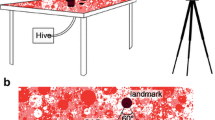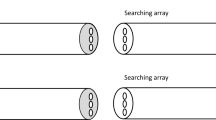Abstract
Bees and wasps acquire a visual representation of their nest's environment and use it to locate their nest when they return from foraging trips. This representation contains among other features cues to the distance of near-by landmarks. We worked with two species of ground-nesting bees, Lasioglossum malachurum (Hymenoptera: Halictidae), Dasypoda hirtipes (Hymenoptera: Melittidae) and asked which cues to landmark distance they use during homing. Bees learned to associate a single cylindrical landmark with their nest's location. We subsequently tested returning bees with landmarks of different sizes and thus introduced large discrepancies between the angular size of the landmark as seen from the nest during training and its distance from the nest. The bees' search behaviour and their choice of dummy nest entrances show that both species of ground-nesting bees consistently search for their nest at the learned distance from landmarks. The influence of the apparent size of landmarks on the bees' search and choice behaviour is comparatively weak. We suggest that the bees exploit cues derived from the apparent speed of the landmark's image at their retina for distance evaluation.
Similar content being viewed by others
References
Ayasse M (1989) Visuelle und olfaktorische Orientierung in der Nestfindung bei Lasioglossum malachurum (Hymenoptera: Halictidae). Apidologie 21: 349–351
Cartwright BA, Collett TS (1979) How honey-bees know their distance from a near-by visual landmark. J Exp Biol 82: 367–372
Cartwright BA, Collett TS (1983) Landmark learning in bees. Experiments and models. J Comp Physiol 151: 521–543
Chmurzynski JA (1963) Some remarks on the optics of the Bembex rostrata (L.) eye (Hymenoptera, Sphegidae). Zoologica Poloniae 13: 111–135
Collett TS (1992) Landmark learning and guidance in insects. Phil Trans R Soc Lond B 337: 295–303
Collett TS, Lehrer M (1993) Looking and learning: a spatial pattern in the orientation flight of the wasp Vespula vulgaris. Proc R Soc Lond 252: 129–134
Collett TS, Fry SN, Wehner R (1993) Sequence learning by honeybees. J Comp Physiol A 172: 693–706
Horridge GA (1986) A theory of insect vision: velocity parallax. Proc R Soc Lond B 229: 13–27
Iersel JJA van, Assem J van den (1964) Aspects of orientation in the digger wasp Bembix rostrata. Anim Behav Suppl 1: 145–162
Kukuk P, Breed MD, Sobti A, Bell WJ (1977) The contributions of kinship and conditioning to nest recognition and colony member recognition in a primitively eusocial bee, Lasioglossum zephyrum (Hymenoptera: Halictidae). Behav Ecol Sociobiol 2: 319–327
Lehrer M (1991) Bees which turn back and look. Naturwissenschaften 78: 274–276
Lehrer M (1993) Why do bees turn back and look? J Comp Physiol A 172: 549–563
Lehrer M, Collett TS (1994) Approaching and departing bees learn different cues to the distance of a landmark. J Comp Physiol A (in press)
Lehrer M, Srinivasan MV (1993) Object detection by honeybees: Why do they land on edges? J Comp Physiol A 173: 23–32
Pfau (1990) Die Hosenbienen des Mainzer Bahndammes. Beobachtungen an einer Kolonie von Dasypoda hirtipes. Natur und Museum 120: 1–10
Ross HT, Ross AC, Ross JRP (1984) A textbook of entomology. 4th ed., Wiley, New York
Srinivasan MV (1992) How bees exploit optic flow: behavioural experiments and neural models. Phil Trans R Soc Lond B 337: 251–379
Srinivasan MV, Lehrer M, Zhang SW, Horridge GA (1989) How honeybees measure their distance from objects of unknown sizes. J Comp Physiol A 165: 605–613
Srinivasan MV, Lehrer M, Kirchner W, Zhang SW (1991) Range perception through apparent image speed in freely flying honeybees. Visual Neurosci 6: 519–536
Wcislo WT (1992) Nest localization and recognition in a solitary bee, Lasioglossum (Dialictus) figueresi Wcislo (Hymenoptera: Halictidae), in relation to sociality. Ethology 92: 108–123
Wehner R, Räber F (1979) Visual spatial memory in desert ants, Cataglyphis bicolor (Hymenoptera: Formicidae). Experientia 35: 1569–1571
Zeil J (1993a) Orientation flights of solitary wasps (Cerceris; Sphecidae; Hymenoptera): I. Description of flight. J Comp Physiol A 172: 189–205
Zeil J (1993b) Orientation flights of solitary wasps (Cerceris; Sphecidae; Hymenoptera): II. Similarity between orientation and return flights and the use of motion parallax. J Comp Physiol A 172: 207–222
Zeil J, Kelber A (1991) Orientation flights in ground-nesting bees and wasps share a common organisation. Verh Dtsch Zool Ges 84: 371
Author information
Authors and Affiliations
Rights and permissions
About this article
Cite this article
Brünnert, U., Kelber, A. & Zeil, J. Ground-nesting bees determine the location of their nest relative to a landmark by other than angular size cues. J Comp Physiol A 175, 363–369 (1994). https://doi.org/10.1007/BF00192995
Accepted:
Issue Date:
DOI: https://doi.org/10.1007/BF00192995




